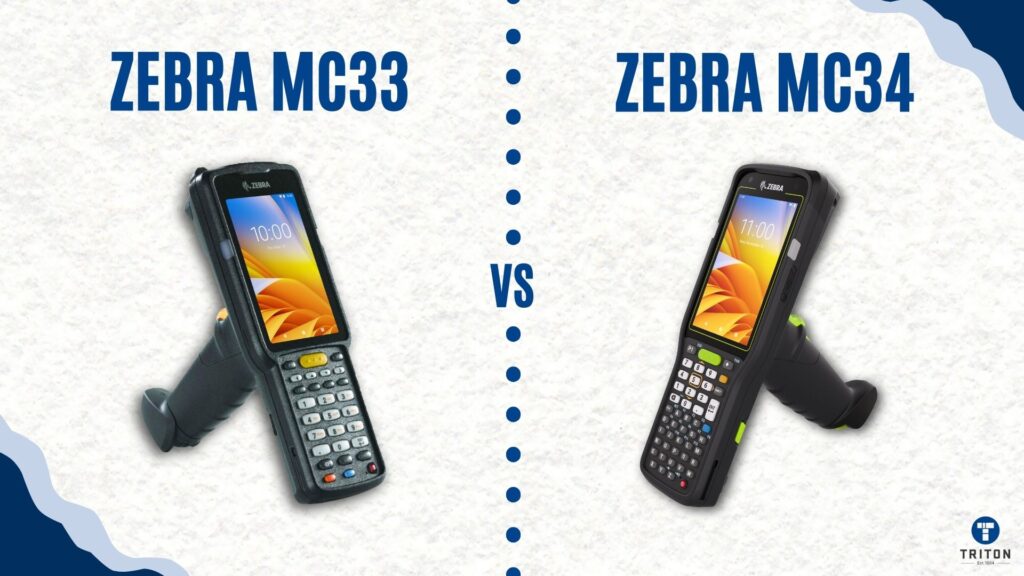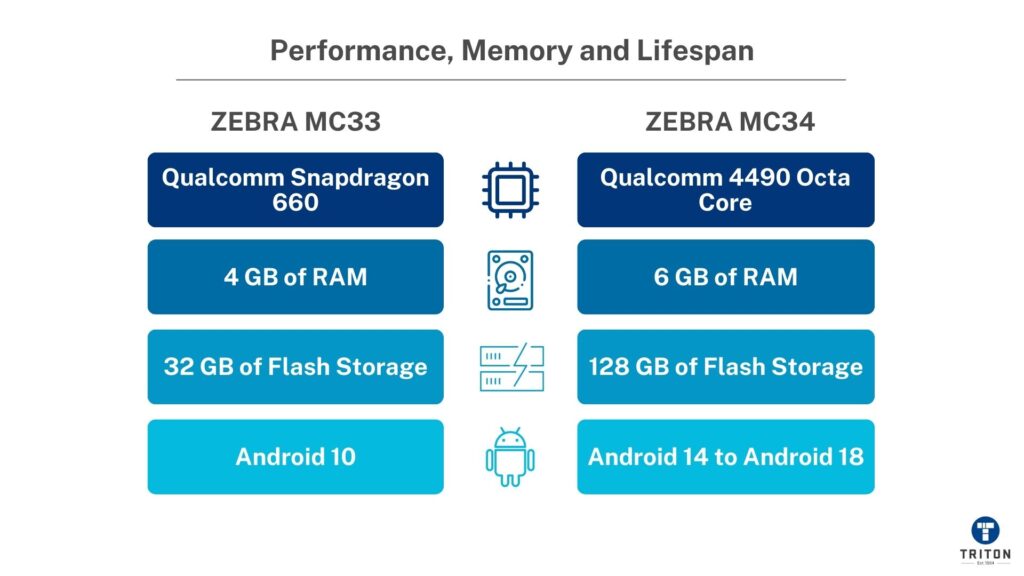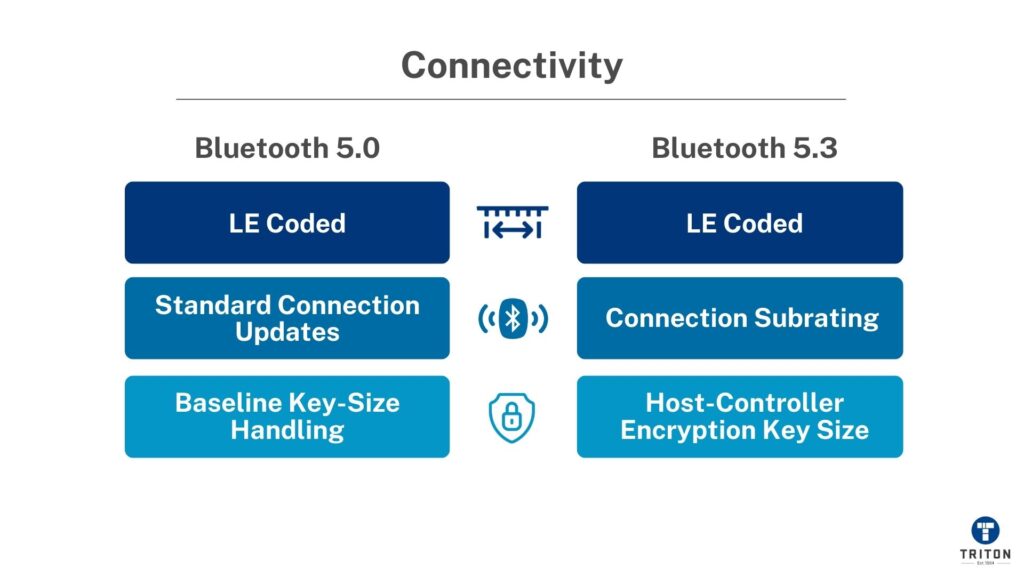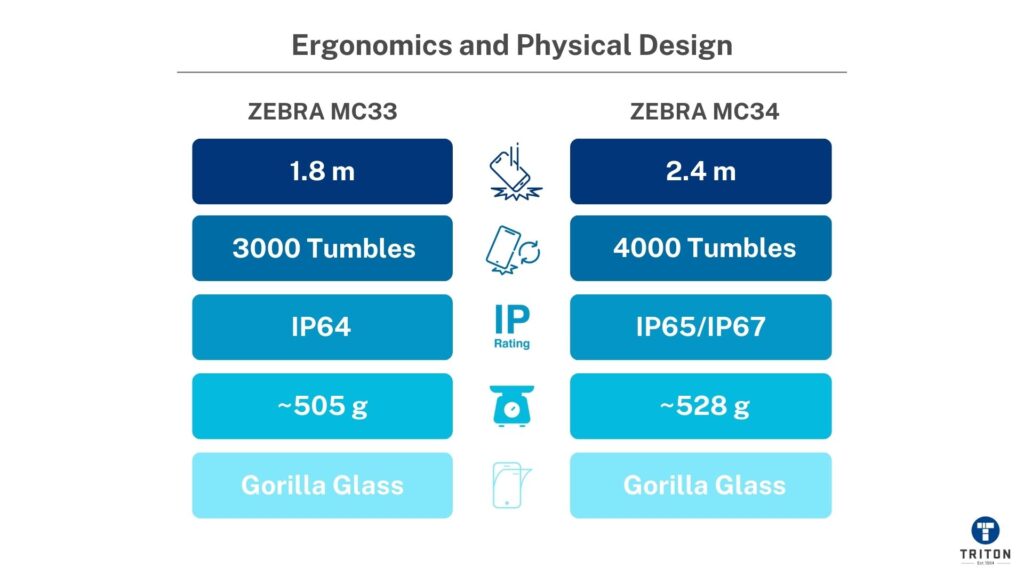
Purchasing the suitable mobile computer for your warehouse or production line is a decision that impacts productivity for years. This article compares two leading key-based devices from Zebra: the dependable Zebra MC3300x and the next-generation Zebra MC3400/MC3450.
We provide a direct comparison to help purchase managers select the best fit for their operations and budget.
We will examine the core differences in processing power, from the MC33’s Snapdragon 660 to the MC34’s more powerful Qualcomm 4490 processor. The analysis covers upgrades in connectivity, including the MC34’s Wi-Fi 6E and 5G options, and improvements in scanning range and device toughness.
This guide breaks down the technical specifications into practical insights and will help you decide whether to stay with the proven MC33 or invest in the future-ready MC34 series.
The Zebra MC34 series is a generational leap over the MC33X, engineered to increase productivity and lower the total cost of ownership in high-volume e-commerce, manufacturing, and large-scale logistics environments.
Zebra MC34 has a Qualcomm 4490 processor that delivers nearly 2.5 times more power to run complex applications smoothly. Wi-Fi 6E and optional 5G provide fast, reliable connectivity for real-time data transfer across large facilities and outdoor yards.
Physically, Zebra MC34 is built for better reliability with an improved 8 ft (2.4 m) drop rating and superior IP65/IP67 sealing against water and dust.
These power, connectivity, and ruggedness upgrades deliver measurable gains in operational efficiency and a longer service life.
The following points break down the significant distinctions between the two series.
Buying factor | Zebra MC3450 | Zebra MC3400 | Zebra MC3300x |
|---|---|---|---|
Primary fit | Sites needing 5G + Wi-Fi 6E and very long range scanning | Sites standardising on Wi-Fi 6E only | Sites on Wi-Fi 5 with MC32/MC33 fleet continuity |
Cellular | 5G (NSA/SA), nano-SIM + eSIM | None | None |
GNSS
| Yes | No | No |
WLAN | Wi-Fi 6E, tri-band, 2×2 MU-MIMO, up to 2402 Mbps | Wi-Fi 6E, tri-band, 2×2 MU-MIMO, up to 2402 Mbps | Wi-Fi 5 (802.11a/b/g/n/ac), 2×2 MU-MIMO, up to 866.7 Mbps |
Scan engines | SE4710/SE4770; SE55 Advanced Range; SE58 Extended Range | SE4710/SE4770; SE55 Advanced Range; SE58 Extended Range | SE965 1D; SE4770/SE4720 2D; SE4850 Extended Range |
Max scan range | Up to 30.5 m (SE58) | Up to 30.5 m (SE58); up to 12.2 m (SE55) | Up to 21.4 m (SE4850); typical 1D to 4.9 m (SE965) |
Form factors | Straight shooter; gun | Straight shooter; gun | 0°, 45°, turret, pistol |
Display / input | 4″ WVGA; 29/38/47-key options | 4″ WVGA; 29/38/47-key options | 4″ WVGA; 29/38/47-key options |
Cameras | 13 MP rear, 5 MP front | 13 MP rear, 5 MP front | Up to 13 MP rear (model dependent) |
Battery / hot-swap | 7000 mAh; hot-swap with session persistence; optional BLE battery for device finding | 7000 mAh; hot-swap with session persistence; optional BLE battery for device finding | 7000 mAh; hot-swap with session persistence |
Rugged rating | IP65/IP67; 2.4 m drops (23 °C); 1.8 m across temp; 4,000 tumbles | IP65/IP67; 2.4 m drops (23 °C); 1.8 m across temp; 4,000 tumbles | IP64; 1.8 m drops across temp; 3,000 tumbles |
CPU / memory | QCM/SD 4490 2.4 GHz; 4-6 GB RAM; 64-128 GB flash | QCM/SD 4490 2.4 GHz; 4-6 GB RAM; 64-128 GB flash | Snapdragon 660 2.2 GHz; 4 GB RAM; 32 GB flash |
Android support | Upgradeable: Standard to Android 15; Expanded/Full to Android 18 | Upgradeable: Standard to Android 15; Expanded/Full to Android 18 | Ships Android 10 with LifeGuard support |
Weights (approx.) | Straight 442 g; gun 528 g | Straight 442 g; gun 528 g | Straight ~375 g; gun ~505 g |
Accessory continuity | Compatible with MC33-series batteries/chargers | Compatible with MC33-series batteries/chargers | MC33-series ecosystem |
Terminal emulation | Ivanti Velocity pre-installed/licensed (per model notes) | Ivanti Velocity pre-installed/licensed (per model notes) | Wavelink ATTE included (gun pre-licensed) |
Typical deployments | Yards, ports, outdoor cross-dock, large sites needing 5G and 30 m scans | Greenfield Wi-Fi 6E warehouses and DCs | Brownfield Wi-Fi 5 warehouses with long-range up to 21.4 m |
The Zebra’s MC33 platform is available in four ergonomic form factors to fit different workflows: pistol grip, rotating turret head, 0-degree straight shooter, and 45-degree angled head. This flexibility lets organisations match the device to the physical demands of their environment, from standard picking to high-rack scanning.
Scan engine options cover a wide range of distances and barcode types:
Form factor | Available scan engines | Camera option |
|---|---|---|
Brick / Straight Shooter (0°) | SE965 1D; SE4720/SE4770 2D; SE4850 ERI | Optional 13 MP rear camera |
Turret / Rotating Head | SE965 1D | Optional 13 MP rear camera |
Gun / Pistol | SE965 1D; SE4270/SE4770 2D; SE4850 ERI | 13 MP rear camera (pre-licensed TE) |
45° Scan | SE4770 2D | No rear camera option |
Form factor | Use case | Ergonomic benefits | Ergonomic downsides |
|---|---|---|---|
Pistol grip | High-volume picking and scan-intensive warehouse work | Reduces wrist strain for repetitive scans, natural trigger use | Bulkier in tight picking carts or confined spaces |
Rotating turret head | Rotating turret head
Mixed orientation scanning without repositioning wrist
| Improves line-of-sight in tight spaces | Adds mechanical complexity, not ideal for harsh impact zones |
0° straight shooter | General purpose scanning, conveyor work | Simple and versatile | Fatiguing for extended high-shelf scanning |
45° angled head | Shelf and bin scanning with minimal wrist tilt | Reduces bending for low and high shelf scans | Less efficient for flat-surface barcode placement |
The MC34 series builds on the MC33 platform with more powerful processor, expanded memory, improved ruggedness, and modern wireless connectivity. It comes in two variants:
Both models are offered in two form factors: straight shooter and gun grip, optimised for scan-intensive tasks.
Scan engine choices extend from short-range to ultra-long range:
Form factor | Available scan engines | Camera option |
|---|---|---|
Straight shooter (brick) | E4710 1D/2D; SE4770 1D/2D; SE55 Advanced Range; SE58 Extended Range | 13 MP rear; 5 MP front (all models) |
Gun | SE4710 1D/2D; SE4770 1D/2D; SE55 Advanced Range; SE58 Extended Range | 13 MP rear; 5 MP front (all models) |

A device’s core components dictate its speed and useful life in your operations. The MC34 has superior specifications that deliver measurable gains in application performance and a longer operational lifecycle.
The MC34 integrates a Qualcomm 4490 octa-core processor running at 2.4 GHz, providing nearly 2.5 times more processing power than the MC33X’s 2.2 GHz Qualcomm Snapdragon™ 660 processor.
The superior chip allows the device to run multiple enterprise applications, such as a warehouse management system (WMS), push-to-talk clients, and inventory tools, concurrently without performance decay. Data-intensive operations, like processing high-resolution proof-of-delivery images, are also completed with less delay.
The MC33X has a standard configuration of 4 GB of RAM and 32 GB of Flash storage. The MC34 series offers configurations up to 6 GB of RAM and 128 GB of Flash, a 50% increase in RAM and a four-fold increase in storage. The larger RAM allows your team to switch between active applications seamlessly, eliminating reload times.
The increased Flash storage accommodates large databases, detailed product image catalogues for retail, and extensive device logs for performance analytics, all stored locally for offline access.
The MC3300x ships with Android 10 and is supported through Zebra’s LifeGuard security update program for its service life. This provides predictable OS stability for organisations running established applications, but may limit access to newer Android platform features beyond its planned support horizon.
The MC34 platform has a significantly longer lifespan. It ships with Android 14 and offers guaranteed upgrades to Android 15 for the Standard tier, and up to Android 18 for the Expanded and Full tiers.
The longer roadmap of the MC34 platform ensures that devices remain compatible with upcoming enterprise applications, modern APIs, and evolving mobile security standards, including future Android Enterprise features and WPA3 security enhancements.
The MC33X handhelds offer a choice of three scan engines.
These are the SE965 1D laser for linear barcodes, the SE4770 or SE4720 2D imagers for standard omnidirectional scanning, and the SE4850 Extended Range Imager (ERI) for reading barcodes from a distance.
The MC34 series also has the standard SE4710 and SE4770 imagers, plus the following two advanced options:
A scanner’s read range dictates operator efficiency and safety. The MC33X, when equipped with the SE4850 engine, can capture 1D and 2D barcodes from as close as 7.6 cm (3 in) to a maximum distance of 21.4 m (70 ft).
The MC34 has c. 43% longer range.
With the SE58 engine, operators can scan barcodes from up to 30.5 m (100 ft) away. More extended scan range permits workers in yards, ports, and large warehouses to read container or high-bay location codes without moving equipment or using lifting gear.
The MC34 series includes a 13 MP rear camera and a 5 MP front camera on every model. Previously, the 13 MP rear camera was limited to the straight-shooter form factor; now it is standard even on the gun model. The front camera uses Identity Guardian’s facial recognition to support push‑button video calls and biometric logins.
By contrast, the MC3300x only has an optional 13 MP rear camera for documentation such as proof of condition or compliance. This feature is omitted from specific models, notably the 45° angled variant. Front-facing camera is unavailable in MC3300x series.
The uniformity of camera configuration on the MC34 series simplifies deployment, training, and support. It ensures consistent imaging, secure login, and remote-assist workflows across your handheld computers.

The primary connectivity difference is the MC34’s support for Wi-Fi 6E and optional 5G cellular data.
Wi-Fi 6E offers theoretical data rates up to 2402 Mbps – over twice the MC33X’s Wi-Fi 5 maximum – while reducing latency and improving efficiency in dense wireless environments.
The MC33X operates on the IEEE 802.11ac (Wi-Fi 5) standard, delivering data rates up to 866.7 Mbps using 2×2 MU-MIMO technology, a reliable standard for most existing enterprise networks.
The MC34 series advances to Wi-Fi 6E (802.11ax). This standard introduces a third band for communication (the 6 GHz band) and the standard 2.4 GHz and 5 GHz bands.
The additional band gives more non-overlapping channels, which reduces interference.
The MC33X platform is a WLAN-only device with no cellular or GNSS capabilities.
The MC3450 model, which integrates 5G and 4G LTE cellular radio, offers more connectivity options. MC3450 also supports a physical nano-SIM and an eSIM, and can connect to two different networks.
The MC3450 also includes multi-constellation GNSS for precise location tracking. GNSS enables real-time data connection and location-based services for workers in large yards, ports, or the field where Wi-Fi is unavailable.
MC33X uses Bluetooth 5.0 for connecting peripherals like headsets and ring scanners.
The MC34 series has been upgraded to Bluetooth 5.3 with a secondary BLE radio for beaconing. The BLE radio which can be used with an optional BLE battery is used for device location. Bluetooth 5.3 improves connection reliability, security, and power efficiency, ensuring a stable link with connected peripherals.
Capability (handheld scanner view) | Bluetooth 5.0 | Bluetooth 5.3 | Operational impact for scanners | |
|---|---|---|---|---|
PHY options & data rate | LE 1M + LE 2M (2 Mbit/s PHY) | Same PHY set as 5.0 | LE 2M shortens airtime for HID/ring‑scanner data and firmware updates. | |
Long‑range mode | LE Coded (S=2/S=8, 500/125 kbps with FEC) | Same LE Coded support | More stable links to peripherals at distance or through racking. | |
Advertising | Extended & Periodic Advertising (uses all 40 LE channels; larger payloads) | Periodic Advertising Enhancement (AdvDataInfo lets listeners drop duplicates) | Better beacon density (5.0); lower listener power for device‑finding beacons (5.3). | |
Channel use / coexistence | Improved channel selection algorithm (CSA#2) | LE Channel Classification from peripheral (both sides inform channel map) | Fewer retries in RF‑noisy warehouses; higher link reliability. | |
Connection responsiveness | Standard connection updates (latency to change intervals) | Connection Subrating for faster switch between low/high duty cycles | Quicker wake‑to‑transmit for bursty scans; snappier peripheral response. | |
Security controls (BR/EDR) | Baseline key‑size handling | Host-Controller Encryption Key size controls (read/set min key size) | Clearer enforcement of link‑key strength policies. | |
Typical scanner peripherals | Reliable with rings, headsets; benefits from LE 2M/LE Coded | All 5.0 benefits plus subrating/channel‑classification/power‑savings | More stable audio/BT accessories; better battery life during beacon listening. |
A device’s physical resilience and design directly influence its longevity and user comfort, impacting total cost of ownership and worker productivity. The MC34 is engineered with quantifiably better durability specifications than the MC33X.
Mobile computers in warehouses and yards are frequently dropped and knocked. The MC33X is built to withstand drops from 1.8 m (6 ft) to concrete across its operating temperature range and is rated to survive 3,000 tumbles from a height of 1 m.
The MC34 improves on these numbers.
It is rated for 2.4 m (8 ft) drops at room temperature and handles 1.8 m drops across the operating temperature range. It is also built to endure 4,000 1m high tumbles.
MC34 has a 33% better tumble endurance and a higher top drop rating, making it better equipped to survive the physical demands of modern logistics and supply chains, leading to fewer repairs and operational downtime.
The Ingress Protection (IP) rating measures resistance to dust and water. The MC33X has an IP64 rating. The number ‘6’ indicates that it is fully protected from dust ingress, while the number ‘4’ indicates that it can resist water splashes from all directions.
The MC34 has a superior dual IP65 and IP67 rating. It’s dust tight, just like MC33X. The number ‘5’ rating means that it is protected against low-pressure water jets, and it can be safely used in rains. The number ‘7’ rating certifies that it can survive fully submerged in water up to 1 m deep for 30 minutes.
This makes the MC34 more suitable for outdoor use in rainy conditions or in environments like food manufacturing, where regular wash-downs are required.

While the MC33X offers four form factors (pistol, turret, 0°, and 45°), the MC34 streamlines the choice to a straight shooter and a gun grip.
The MC34 models are slightly heavier, a direct trade-off for their increased ruggedness. The MC34 gun model weighs 528 g, compared to the MC33X gun at 505 g.
A notable ergonomic improvement in the MC34 is its keypad. It features larger keys with more space between them, a design choice made specifically to make data entry easier and more accurate for workers wearing gloves.
Both devices protect their displays and scanner windows with Corning Gorilla Glass for high scratch and impact resistance.
Specification | MC3300x | MC34 (MC3400/MC3450) |
|---|---|---|
Drop Spec | 1.8 m (6 ft) | 2.4 m (8 ft; MIL-STD-810H) |
Tumbles | 3,000 | 4,000 |
IP Rating | IP64 (dust/splash) | IP65/IP67 (water-jet/submersion) |
Form Factors | 4 (pistol, turret, 0°, 45°) | 2 (straight, gun) |
Weight (Gun) | ~505 g | ~528 g |
Keypad | Standard | 12 % larger, gloved entry focused |
Glass Protection | Gorilla Glass | Gorilla Glass |
Both platforms are built on Zebra’s Mobility DNA software suite, and both come ready to integrate with legacy systems using pre-installed terminal emulation (TE) software. However, the MC34 series has new security and device management capabilities that are not available on the MC33X.
The MC34 provides a superior security feature called Identity Guardian, which uses the device’s standard 5 MP front-facing camera for biometric facial recognition for fast, secure, and auditable user authentication.
The MC33X lacks this capability as it does not have a front-facing camera. For operations handling sensitive inventory or customer data, the MC34’s biometric login offers higher security against unauthorised access.
For example, in pharmaceutical logistics, where workers track controlled substances, biometric login creates a non-repudiable audit trail for every scan. Similarly, for a driver on a direct store delivery route, it prevents unauthorised access to a customer list containing names and addresses.
While both platforms support Zebra’s Device Tracker software, the MC34 offers a critical hardware advantage for finding misplaced units.
MC34 can be equipped with an optional BLE (Bluetooth Low Energy) battery, which broadcasts a signal even if the device is powered off or the main battery is depleted.
The MC33X does not have this BLE battery option, meaning its device-finding capability works only when it has power. This MC34 feature drastically reduces the time and cost associated with lost assets, improving device lifecycle management and lowering replacement expenses.
The total cost of a device extends well beyond its purchase price.
It includes deployment, training, maintenance, and eventual replacement. The MC34 platform reduces long-term TCO through a service life up to five years longer than the MC33X and by reusing existing accessories.
The MC3300x ships with Android 10 and is supported for security patches and at least one major OS upgrade through Zebra’s LifeGuard program.
The MC34 series is compatible with most MC3300-series batteries, chargers, and cradles. Accessory reuse during fleet upgrades reduces capital expenditure.
The MC34 series operates on Android 14 and offers upgrade paths to Android 15 (Standard) or Android 18 (Expanded/Full), compared with the MC3300x’s Android 10 base and more limited upgrade path. The extended OS roadmap gives a longer deployment window.
MC34 series hardware support for Wi-Fi 6E (up to 2402 Mbps) and optional 5G makes it “next-generation network” ready and avoids costly mid-life connectivity bottlenecks and premature device replacement.
Both platforms ship with pre-licensed terminal emulation software for legacy green-screen applications: Wavelink ATTE on the MC3300x gun configuration and Ivanti Velocity on all MC34 models, eliminating separate licensing costs.
Extended OS upgrades, network future-proofing, and accessory continuity give the MC34 a measurable TCO advantage, especially for fleets exceeding 100 units, where savings can reach six figures over the device lifecycle.
The Zebra MC33X and Zebra MC34 Series are powerful, key-based mobile computers for harsh industrial environments.
Choose the MC33X for its proven reliability in established Wi-Fi 5 workflows and diverse ergonomic options.
Opt for the MC34 because of its superior processing power, future-proof Wi-Fi 6E and 5G connectivity, and longer operational life backed by an extended Android support roadmap, which makes the MC34 the clear choice for modernising your operations.
Visit the Triton Store to find the right Zebra scanner to keep your business running at peak efficiency.